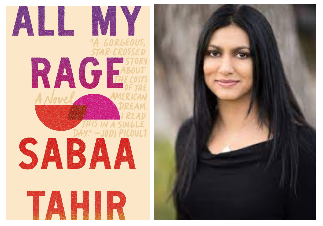‘All My Rage’ is all the rage

“All My Rage” by Sabaa Tahir covers themes surrounding friendship and loss, grief and anger, hope and forgiveness, and generational trauma.
May 8, 2022
“All My Rage” by Sabaa Tahir covers themes surrounding friendship and loss, grief and anger, hope and forgiveness, and generational trauma. I read the novel last week, and it is one of the most impactful books I’ve ever read thanks to the impeccable way Tahir adds to the conversation surrounding commonly taboo topics with multi-dimensional characters and a tense, but realistic plot.
Trigger warnings in this book include domestic violence, alcohol abuse, and Islamophobia. If you are triggered by any of those things, avoid this book, or read it with caution. If not, I find that Tahir weaves them into the bones of the story in a way that the book doesn’t become a political stance like many books can, but a window into the lives of two teenagers, likely representative of what teenagers around the world are experiencing.
Spoiler free:
We follow Noor and Salahudin in Juniper, California, two best friends who had a falling out. Their friendship lives at the heart of this story and drives most of the main plot points. The story begins with Salahudin’s mother’s health failing, and his father losing himself in alcoholism due to his grief. Noor lives with her uncle after her entire family died in an earthquake in Pakistan, and is trying to do everything she can to get into college and escape Juniper.
After his mother’s health declining, Salahudin begins to try to keep the motel his family owns afloat, and throughout the novel, he repairs his friendship with Noor, bonding over the loss of someone they both loved.
I found that the book started off rather slow, with redundant scenes throughout the first few chapters meant solely to establish the complex relationship between Noor and Salahudin. While I appreciate the necessity of this from a craft perspective, I found myself not that excited to continue reading until we reached the second section.
From there on, everything picked up. We got to see different layers to each character as bits of the past unfolded. “All My Rage” adds to the conversation of coping with grief and the loss of a loved one, but realistically shows how difficult it can be to do that with outer conflicts, including paying bills, keeping a business alive, bullying, abuse, and conflict in relationships. The tension throughout the novel is spectacularly built, slowly but surely leading to a climax and ending that will leave the reader thinking about it for hours.
Spoilers:
Moving on to my thoughts on the novel as a whole (including spoilers):
One of the first things I noticed as I read was that the novel and the main plot points were structured well and allowed for enough tension to build up that I had absolutely no clue how the characters would get out of it.
Every novel has two main arcs—that of the characters’ development and the plot. Usually, it’s difficult for authors to intertwine them and they end up being combined, but Tahir spectacularly uses both to time the main plot points and developments perfectly. For example, right when Noor and Salahudin’s relationship reaches its climax (they finally get together), everything in the outside world goes wrong (the police stop them and they get arrested; Noor realizes Salahudin lied to her and kept secrets). The fact that Noor realizes Salahudin betrayed her right after finally fully trusting him makes the betrayal hurt that much more, and the fact that the plot all went downhill means they weren’t able to resolve the conflict for a while.
Secondly, the smaller details present throughout the novel that made reappearances every once in a while tied everything together and added an extra layer to make the world more believable. For example, Noor repeats a paragraph in her head from the beginning of the novel describing her Uncle Chachu, explaining how he’s the only reason she’s in America and he continued to dig through rubble of an earthquake to save her.
The exact phrasing of her paragraph is repeated over and over throughout the novel, and ends up being one of the main catalysts by end of the second act that shows the physical and psychological abuse she was subject to all her life.
Lastly, I loved that the novel had realistic consequences for all the actions taken. A great example is the consequences Salahudin has to face for selling drugs. He does end up in prison, which isn’t a satisfying ending as a reader to see for a character we’ve been rooting for, but it shows realistic consequences for problems that many people around the country actually face.
Ultimately, this novel is one of the most impactful stories I’ve read due to the way it broaches difficult topics not commonly talked about without directly taking a stance and telling the readers what to think. Tahir places the characters in situations and uses the novel as a window to allow readers a glimpse into what life can be like in certain situations.





